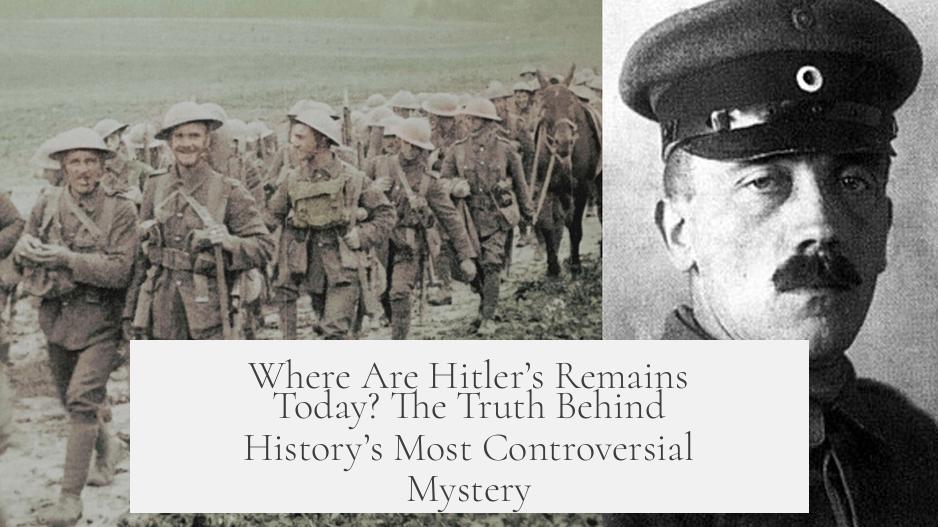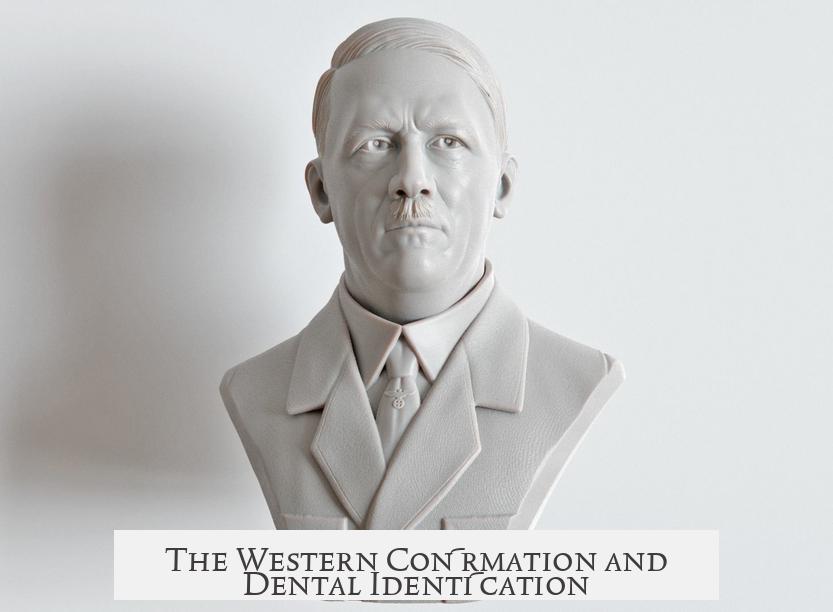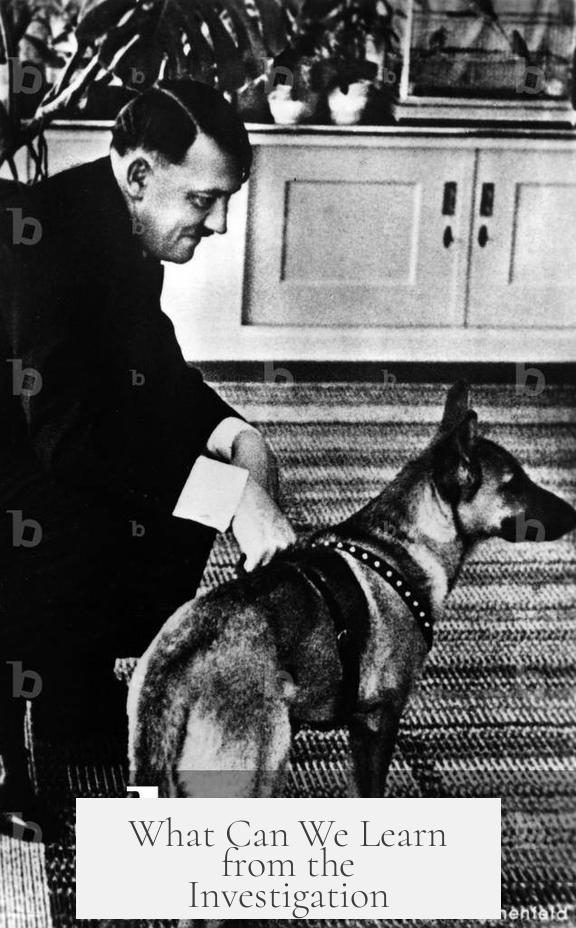Adolf Hitler’s remains today do not exist as a verified, intact body but rather as limited physical evidence primarily confirmed through dental identification and witness testimony. Although rumors and conspiracy theories about Hitler’s survival continue, credible investigations and legal declarations affirm his death on April 30, 1945, at his Berlin bunker.
Hitler died by suicide in his bunker as Soviet forces closed in on Berlin. This event was witnessed by several individuals inside the Führerbunker and quickly communicated to Allied forces. Within days, the Soviet Army confirmed Hitler’s death, notably when General Hans Krebs informed General Vasily Chuikov, who responded, “We know.”
Despite this, conspiracy theories about Hitler’s survival began almost immediately. These rumors persisted for decades, fueled by reports placing him in remote locations such as South America, Scandinavia, or even various European cities. The FBI archive contains numerous investigations into such rumors, including incidents as far-fetched as hotel sightings in Quebec. These investigations found no credible evidence to support survival claims. The public availability of these documents underscores their nature as rumors without substantial proof.
Physical remains recovered by Soviet forces provide the strongest evidence that Hitler died in 1945. His and Eva Braun’s bodies were burned in a garden behind the bunker following their suicides. Soviet search teams later discovered charred remains and some artifacts, including a fragment of a skull with a bullet hole. However, this skull fragment’s authenticity as Hitler’s has come into question with modern forensic analysis.
In 2009, a DNA test performed on the skull fragment held by Russian state archives revealed that it belonged to a female under 40 years old, not Hitler, who was 56 at the time of his death. This finding challenges the identification of this skull as Hitler’s but does not undermine the larger body of evidence. Witness testimony and other remains, such as Hitler’s dental remains, provide more conclusive identification.
| Type of Evidence | Details |
|---|---|
| Witness Testimony | Several bunker survivors described Hitler’s suicide and immediate cremation of remains. |
| Dental Records | Dental remains identified by Hitler’s dentist’s assistants—Fritz Echtmann and Käthe Heusermann—strongly confirmed identity. |
| Physical Remains | Partial burnt remains recovered; skull fragment questioned via DNA testing. |
Western intelligence and historians, notably Hugh Trevor-Roper, conducted detailed investigations after the war. Trevor-Roper’s 1947 report and subsequent book affirmed Hitler’s death narrative based on extensive interviews and evidence. The western consensus accepted these findings, separating confirmed facts from speculative rumors.
Legally, Hitler’s death was formally declared some years later. In 1948 and then through court proceedings in Bavaria from 1952 to 1956, testimony and forensic evidence were reviewed to officially declare him deceased. This decision enabled seizure of his assets and closure of legal matters linked to his estate.
Over the years, the Soviet Union and Russia displayed parts of Hitler’s supposed remains, but skepticism remains, especially about the skull. Despite these controversies, the dental evidence and witness accounts remain the most reliable proof of Hitler’s death. The absence of a complete physical body and the destruction of many remains have perpetuated conspiracy theories, but none stand up to thorough historical and forensic scrutiny.
- Hitler died by suicide in the Berlin bunker on April 30, 1945.
- Conspiracy theories about his survival exist but lack credible evidence.
- The FBI investigated survival claims and found them unsubstantiated.
- Skull fragment once thought to be Hitler’s was DNA tested and identified as female.
- Dental remains identified by Hitler’s dental technicians provide strongest physical proof.
- Western investigations and court rulings affirmed Hitler’s death legally and historically.
- Hitler’s remains were burned and partially recovered, but no complete body exists today.
Where Are Hitler’s Remains Today? The Truth Behind History’s Most Controversial Mystery

The short and firm answer: Adolf Hitler’s physical remains no longer exist in any identifiable or confirmed form today. After his suicide in April 1945, his body was quickly cremated by his closest aides in the ruins of Berlin, and despite decades of speculation, conspiracy theories, and scientific examinations, no authenticated remains are publicly available or accessible. His supposed skull fragment, which stirred controversy for decades, has been debunked as not even his. So, where exactly are the pieces of Hitler’s past—and what happened after the final curtain fell?
Let’s unpack this decades-old puzzle.
The Final Act in the Führer’s Bunker
On April 30, 1945, Adolf Hitler took his own life. Those were desperate times, and Berlin was crumbling around the infamous bunker where he hid. Witnesses present in the final days testified to his suicide—a grim exit to his “Thousand Year Reich” that lasted just 12. Modern history books accept this as fact, supported by the Soviets’ early confirmation. A Wehrmacht general’s message to Soviet forces was met with an unambiguous response: “We know.”
Despite this, rumors about Hitler’s escape—never rooted in solid evidence—started almost immediately.
Conspiracy Theories: An Enduring Fascination
Fast forward decades later, and conspiracy theories about Hitler’s survival refuse to die. Shows like Hunting Hitler still draw viewers fascinated by the “what if” scenarios. People love mysteries, especially when they involve shadowy escapes to South America or hidden Nazi enclaves in Scandinavia. This captivation sparked genuine FBI investigations, which remain publicly accessible for curious researchers today.
Let’s be honest—those stories are wild. One couple even reported seeing Hitler in a Quebec hotel in 1948. But the FBI never found any credible evidence. The files mainly demonstrate how widespread and durable these myths are.
The Soviet Enigma and the Skull Fragment Controversy
Here’s where the story gets juicy—and complicated. The Soviets recovered physical remains in Berlin, including a jawbone and a cautious piece of skull with a bullet hole that seemed to match the assumed cause of death. For decades, this was a significant piece of the puzzle.
But in a fascinating twist in 2009, two forensic experts from the University of Connecticut tested the skull fragment. The DNA results revealed it belonged to a woman under 40 years old. This directly contradicted the notion that it was Hitler’s remains. After all, Hitler was 56 when he died. To add to this, eyewitnesses remember Eva Braun—Hitler’s companion who died by poison—as never shooting a gun. So the skull fragment was likely just the remains of an innocent bystander who perished near the bunker.
This revelation didn’t plunge history into chaos. The Soviets themselves never put all their eggs into the skull basket, prioritizing dental records instead. And even historians remained skeptical about the skull fragment’s provenance.
The Western Confirmation and Dental Identification

While the Soviets remained secretive, the Western Allies pieced together their understanding from eye-witness testimony and critical investigation. Hugh Trevor-Roper, a British intelligence officer and historian, conducted a thorough inquiry after the war. His reports confirmed the general narrative: Hitler and Eva Braun died in the bunker on April 30, 1945.
However, the most conclusive evidence came from dental records—a method painstakingly verified by both Soviet and Western experts. Fritz Echtmann and Käthe Heusermann, associates of Hitler’s personal dentist Dr. Hugo Blaschke, played a vital role. They identified dental remains recovered by the Soviets as matching Hitler’s dental records. This odontological proof effectively sealed the case in the eyes of most historians.
Legal Confirmation and Historical Closure
Remarkably, Hitler was declared legally dead only about a decade after the war. In 1948, Bavaria initiated denazification procedures against him, classing him as a “major offender” in his absence. This enabled them to seize assets connected to him, including the rights to Mein Kampf and his personal belongings.
A legal declaration of death came in 1956 after the thorough investigation of witnesses, forensic results, and historical archives. The district court of Berchtesgaden decided firmly: Hitler was dead.
This official declaration brought a measure of closure, of course, to a dark chapter in history, but questions and conspiracy theories have lingered to this day.
Where Are the Remains Now? A Modern Reflection
So if the Soviet team found body parts in Berlin, what happened to them? The remains were handled quietly by Soviet forces and eventually disappeared into their tightly controlled archives. Some bones were reportedly hidden at a secret location, while ashes and fragments were scattered or stored in places only known internally. It’s widely believed that Hitler’s remains were destroyed to prevent them from becoming a shrine to Nazi sympathizers.
Today, no authenticated remains are available to the public or scholars. The skull fragment controversy highlights the difficulties in verifying such claims after so many years and the chaos at the war’s end. Many historians emphasize that physical remains—even if found—would not alter the factual understanding of Hitler’s death supported by multiple witness testimonies and forensic pieces like the dental records.
Why Do People Still Wonder?
Why does such a morbid fascination endure? Perhaps it’s human nature to question “official” stories, especially about infamous figures. Movies, TV programs, and books keep the intrigue alive. Plus, the shadowy nature of the war, Cold War secrecy, and missing or secret archives add mystery.
However, armed with modern forensic science and decades of diligent research—some including the once-classified FBI files available online—it’s clear that Hitler died in that bunker in 1945. The tales of his escape remain just that: tales.
What Can We Learn from the Investigation?

The saga of Hitler’s remains is a lesson in historical investigation, illustrating how complex facts can become entangled with rumor and myth. It teaches the importance of evidence-based research, use of forensic science like dental identification, and critical evaluation of sources.
So, if you ever stumble across a sensational theory claiming otherwise, remember the solid truths:
- The overwhelming witness reports support the suicide narrative.
- The FBI debunked escape theories after careful inquiries.
- The contested skull fragment was not Hitler’s.
- Dental records remain the most reliable forensic proof of death.
- Legal proceedings in Germany officially concluded Hitler’s death.
And remember, history sometimes involves digging through murky details—literally and figuratively—to reach the facts obscured by time.
Final Thoughts
Hitler’s remains are not neatly encapsulated in a museum or grave site. They are fragments scattered by time and politics, with the public record cemented by solid forensic analyses and legal findings. The skeleton in the bunker is less a physical relic than a symbol of history’s dark twilight. While the skull fragment once stirred global intrigue, science has demystified it. The truth is often less thrilling but infinitely more reliable.
So next time you hear about Hitler’s alleged escape hideouts or secret basements in South America, ask yourself: do these stories hold up to rigorous scrutiny? History demands evidence, not wishful thinking.
Hitler’s remains today exist mostly as confirmed dental fragments in Soviet archives long since lost to public view, with no credible physical remains on display. His death is a settled fact, but the pursuit of the truth continues to fascinate and educate us.




